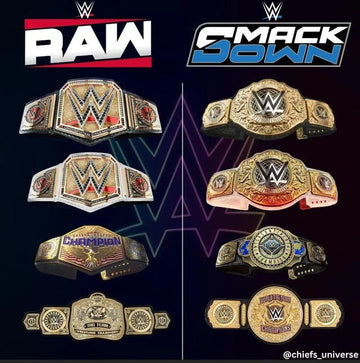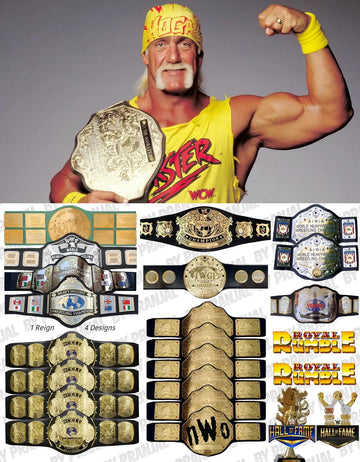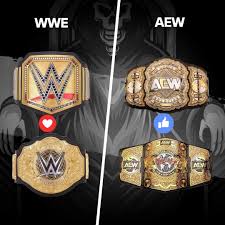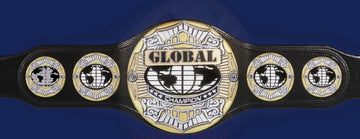In recent years, the fascination with championship belts, especially in the world of professional wrestling, has surged in popularity. Once considered mere props used in the ring to symbolize victory, championship belts have evolved into coveted collectibles that attract fans, historians, and design enthusiasts alike. But what is driving this growing trend? Let’s explore the reasons behind why collecting championship belts has become such a phenomenon.
1. Nostalgia and Connection to Wrestling History
For many wrestling fans, championship belts represent more than just a piece of metal and leather—they are a symbol of iconic moments in wrestling history. From the golden age of the 1980s to the modern era of WWE, fans often collect belts to relive those unforgettable moments and feel a personal connection to their favorite wrestlers and events. For example, the WWE World Heavyweight Championship holds special significance for fans who grew up watching legends like Hulk Hogan, The Rock, and Stone Cold Steve Austin. By owning a piece of wrestling history, collectors experience a sense of nostalgia and a tangible link to the past.
2. The Appeal of Customization
One of the driving factors behind the growing popularity of championship belts is the rise of customization. Fans can now personalize belts to reflect their own preferences, whether it’s a tribute to a favorite wrestler, a creative spin on classic designs, or a unique, one-of-a-kind piece that stands out in any collection. Custom championship belts provide fans with a platform to express their creativity, and many are willing to invest in high-quality, customized belts that showcase their individuality. This level of customization makes championship belts not just collectibles but also personal statements.
3. The Popularity of Wrestling Culture
Wrestling has experienced a resurgence in mainstream popularity, fueled by the rise of streaming platforms, the continuing success of WWE, and the emergence of new promotions like AEW (All Elite Wrestling). With this renewed interest in the sport, the demand for wrestling memorabilia has skyrocketed. Championship belts are now seen as both a piece of wrestling culture and a valuable collectible, making them more desirable to fans who want to showcase their love for the sport.
4. An Investment Opportunity
As with other forms of memorabilia, championship belts can be a smart investment. Rare and limited-edition belts, especially those with historical significance or ties to legendary moments in wrestling, can increase in value over time. Collectors are increasingly viewing championship belts not just as fan items but also as assets that can appreciate in worth. For example, belts once owned by famous wrestlers or used in significant matches are often considered rare treasures in the collector’s market. This blend of passion and investment opportunity makes championship belts a unique and exciting market for both fans and investors alike.
5. The Thrill of the Hunt
For some collectors, the thrill of finding a rare, vintage, or discontinued belt is a major part of the appeal. Much like collecting limited-edition items or autographed memorabilia, hunting for the perfect belt can be an exciting and rewarding experience. Whether it’s tracking down a hard-to-find replica or commissioning a completely custom piece, the search itself becomes an adventure for many fans. This chase for elusive championship belts creates a sense of community among collectors who share stories, tips, and advice on where to find the best deals.
6. Social Media and Online Communities
Social media platforms like Instagram, Facebook, and Twitter have also played a crucial role in the growth of the championship belt collecting trend. Fans and collectors can showcase their collections, interact with fellow enthusiasts, and stay updated on the latest releases and trends. Online communities and forums dedicated to championship belt collecting have made it easier than ever for people to share their passion, learn from others, and even trade or sell belts. The visibility and accessibility of championship belts on these platforms have only fueled their popularity.
7. Cultural Impact and Cross-Promotion
Finally, the cultural impact of wrestling has expanded far beyond the ring. WWE, AEW, and other wrestling promotions frequently partner with mainstream brands and pop culture icons, further cementing the status of championship belts as an emblem of pop culture. From appearances in movies and TV shows to collaborations with music artists and fashion designers, championship belts have become symbols of success, power, and status. As they continue to gain exposure in mainstream media, they only grow in appeal to fans who want to own a piece of this larger-than-life world.
Conclusion
The trend of collecting championship belts has grown far beyond a simple hobby for wrestling fans; it’s become a lifestyle, a passion, and even a lucrative investment for some. Whether it’s the nostalgia, the appeal of customization, or the growing popularity of wrestling culture, championship belts have become highly sought-after collectibles. As the trend continues to rise, fans and collectors alike will undoubtedly continue to add these iconic pieces of history to their collections, keeping the passion for wrestling alive and thriving in new and exciting ways.
FAQs About Collecting Championship Belts
1. Why are championship belts so popular among collectors?
Championship belts are highly popular due to their connection to wrestling history, their cultural significance, and the growing trend of customization. They represent iconic moments, legendary wrestlers, and emotional milestones that resonate deeply with fans. Additionally, the ability to personalize belts and their increasing value as collectibles make them even more desirable.
2. How much does a championship belt cost?
The cost of a championship belt can vary significantly based on factors like the quality, material, design, and rarity. Standard replica belts typically range from $200 to $600, while custom championship belts and limited editions can cost anywhere from $1,000 to several thousand dollars. Vintage or one-of-a-kind belts owned by famous wrestlers may fetch even higher prices.
3. Are custom championship belts worth the investment?
Custom championship belts can be a worthwhile investment, especially if they are made with high-quality materials and feature unique designs. Limited-edition and artist-designed belts can increase in value over time, particularly those tied to memorable events or wrestlers. As with any collectible, their value depends on factors like demand, rarity, and historical significance.
4. How can I make my own custom championship belt?
To make your own custom championship belt, you can reach out to specialized companies that offer custom design services. Many companies allow you to choose the design, materials, and even add your own personal logos or engravings. You can either create a design based on existing belt styles or come up with something completely unique.
5. What is the best way to display a championship belt?
Displaying a championship belt depends on personal preference, but many collectors choose to showcase them in shadow boxes, display cases, or on special stands. Proper storage is also important to maintain the belt's condition—keep them in a dry, cool place to avoid damage from sunlight or humidity. Some collectors even incorporate their belts into their home décor, turning them into a statement piece.
6. Can I buy authentic WWE championship belts used by wrestlers?
Yes, but these belts are incredibly rare and expensive. WWE occasionally auctions off championship belts worn by wrestlers, especially those tied to significant events. Some belts may also be sold through online marketplaces, but authentic belts used by famous wrestlers often come with a hefty price tag. Always verify the authenticity before purchasing.
7. How do I know if a championship belt is authentic?
Authenticity is key when it comes to championship belts. To verify if a belt is authentic, check for signs such as the quality of the craftsmanship, the weight of the materials, and any official branding or markings. For example, WWE belts often feature specific engravings or logos that confirm their authenticity. Always buy from reputable sources to avoid counterfeit items.
8. Are there any online communities for championship belt collectors?
Yes! There are several online communities where championship belt collectors can connect, share their collections, and learn from each other. Websites, Facebook groups, and Instagram pages dedicated to championship belts are great places to discuss designs, purchase belts, and exchange tips. Many collectors also gather on forums to discuss rare finds and trade belts.
9. Can championship belts be used for purposes other than collecting?
While championship belts are mostly associated with collecting, they are also commonly used in wrestling events, both professional and amateur. Many wrestling promotions offer custom belts as prizes, and some fans use championship belts as part of costume or cosplay designs. Additionally, some people buy belts as gifts for loved ones or display them as part of their home décor.
10. What’s the most expensive championship belt ever sold?
One of the most expensive championship belts ever sold was the WWE Championship belt once owned by "Stone Cold" Steve Austin. It was sold at auction for a staggering $100,000, thanks to its historical significance and association with Austin’s legendary career. Rare championship belts tied to significant moments in wrestling history can fetch incredibly high prices, especially if they were used in famous matches or belong to iconic wrestlers.




